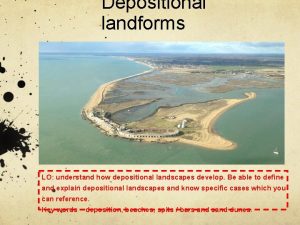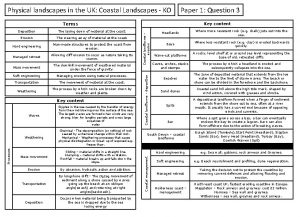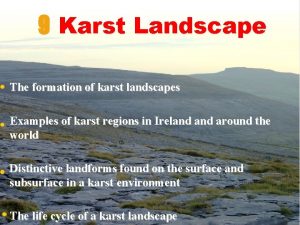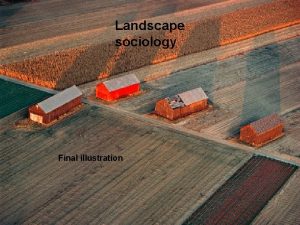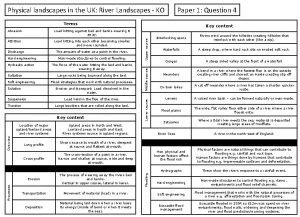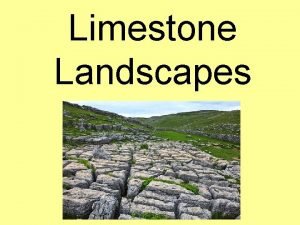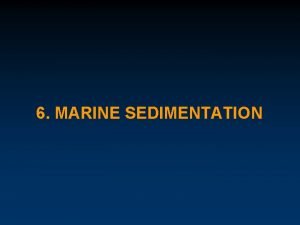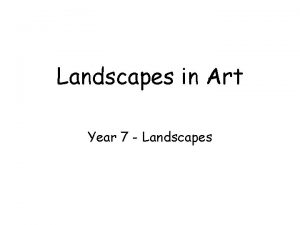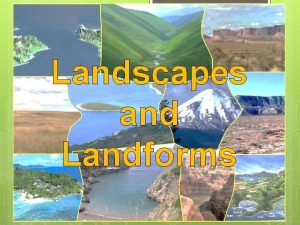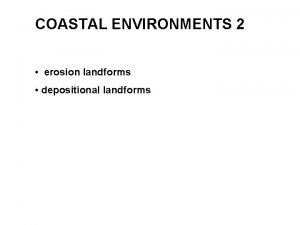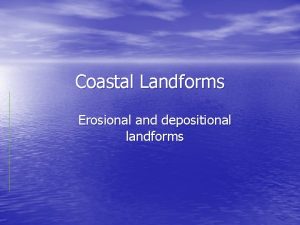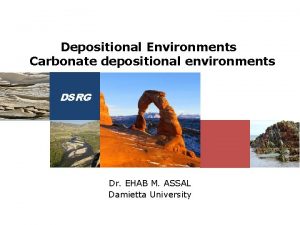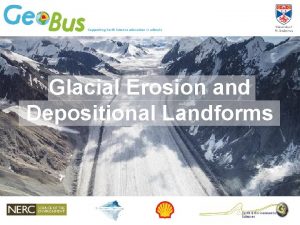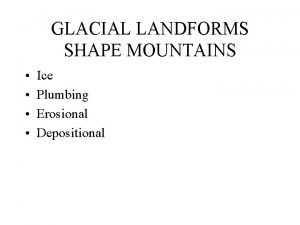Depositional landforms LO understand how depositional landscapes develop

















- Slides: 17

Depositional landforms LO: understand how depositional landscapes develop. Be able to define and explain depositional landscapes and know specific cases which you can reference. Key words – deposition, beaches, spits / bars and sand dunes.

Deposition When water loses its energy, any sediment it is carrying is deposited. The build-up of deposited sediment can form different features along the coast namely: beaches, sand dunes, spits and bars.

Beaches form at the foreshore through the transportation and deposition of material. Large beaches form at coastlines where there is a constant supply of sediment, generally under constructive waves. Constructive waves have dominant swash and transport material up the beach. Coastlines that have dominant destructive wave p atterns tend to have narrower and steeper beaches because of the stronger backwash.

Structure

Beaches are made up from eroded material that has been transported from elsewhere and then deposited by the sea. Sandy beaches are usually found in bays where the water is shallow and the waves have less energy. Pebble beaches often form where cliffs are being eroded, and where there are higher energy waves.

Characteristics

Profile A cross-profile of a beach is called the beach profile. The beach profile has lots of ridges called berms. They show the lines of the high tide and the storm tides.

Spits A spit is an extended stretch of sand or shingle jutting out into the sea from the land. Spits occur when there is a change in the shape of the landscape or there is a river mouth.

You. Tube - video

Exam Tip Describing and explaining the formation of a spit is a common exam question. Remember to always start the sequence with prevailing and refer to swash and back wash. When describing the spit, make sure you make clear reference to its features, e. g. re-curved laterals or hooks, slat 1 Longshore drift moves material along the coastline. march with lagoons and salt resistant 2 A spit forms when the material is deposited. plants 3 Over time, the spit grows and develops a hook if wind direction video changes further out. 4 Waves cannot get past a spit, which creates a sheltered area where silt is deposited and mud flats or salt marshes form.

Bars A spit can grow across a bay and joins two headlands together. This landform is known as a bar. They can trap shallow lakes behind the bar, these are known as lagoons. Lagoons do not last forever and may be filled up with sediment.

Formation of a bar

Sand dunes Dunes form where the beach is wide enough to allow for the accumulation of wind-blown sand, and where prevailing onshore winds tend to blow sand inland. Obstacles—for example, vegetation, pebbles and so on— tend to slow down the wind and lead to the deposition of sand grains.

Formation For a sand dune to form it needs: a large flat beach a large supply of sand a large tidal range an onshore wind an obstacle for the dune to form against (drift wood)

Transportation Wind moves the sand in three ways: 1 Suspension 2 Saltation 3 Creep Sand dunes - video

How do dunes change inland?

 Depositional landscapes
Depositional landscapes Landscapes and landforms booklet
Landscapes and landforms booklet Landscapes and landforms
Landscapes and landforms To understand recursion you must understand recursion
To understand recursion you must understand recursion Examples of karst landscapes in ireland
Examples of karst landscapes in ireland Enchanted definition
Enchanted definition What makes a landscape distinctive
What makes a landscape distinctive Mediorami
Mediorami Uk physical landscapes
Uk physical landscapes Region 5 themes of geography
Region 5 themes of geography Chapter 5 glaciers oceans and landscapes
Chapter 5 glaciers oceans and landscapes Fpm landscapes
Fpm landscapes What is this ?
What is this ? Erosional work of sea waves
Erosional work of sea waves Erosional vs depositional
Erosional vs depositional Definition
Definition Drumlin
Drumlin Develop
Develop
